New York is ripping up the playbook on how it shelters the homeless
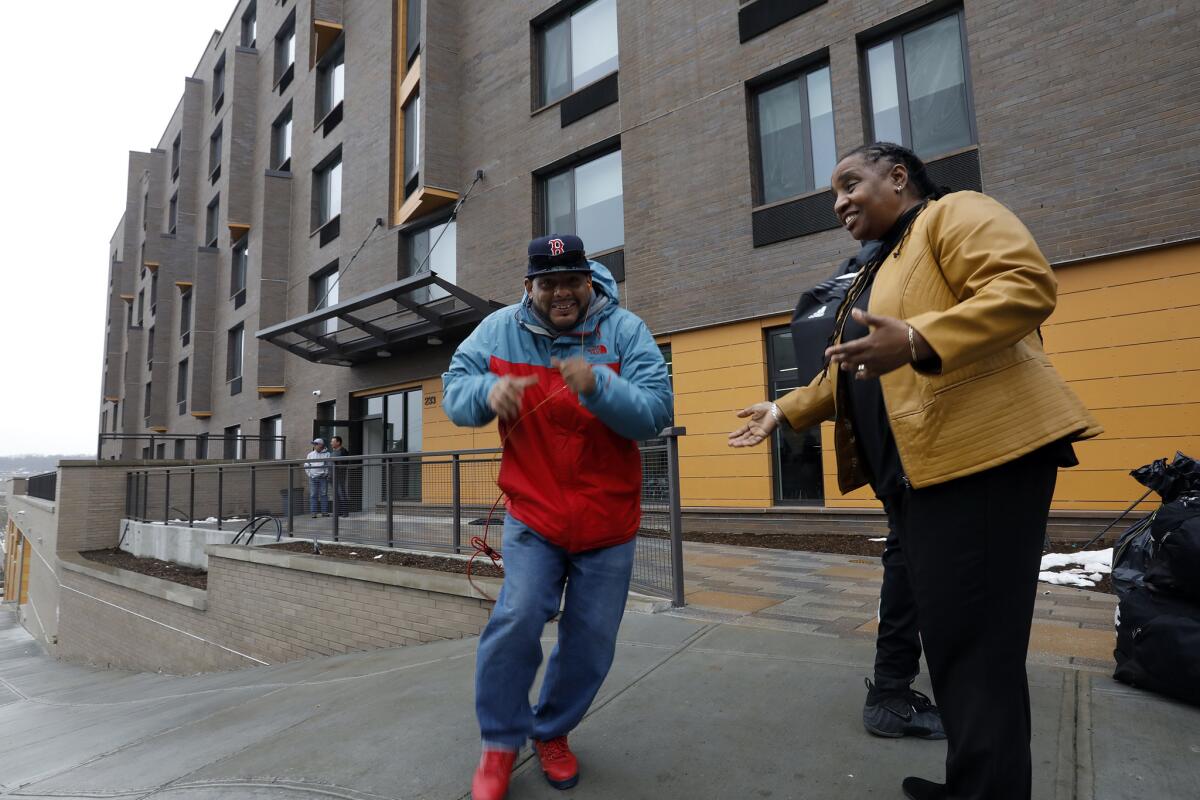
- Share via
Reporting from New York City — As Mayor Bill De Blasio headed toward reelection in 2017, he announced an ambitious plan to address one of New York City’s most intractable problems.
Over the next five years, he said, the city would open 90 new homeless shelters. Gone would be the patchwork quilt of private apartments and commercial hotel rooms rented simply to put a roof over someone’s head. In their place would be a consolidated system of shelters designed not only to house the homeless but connect them to social services in neighborhoods where they already had roots.
“We’ve been moving in the wrong direction for 3½ decades,” De Blasio said.
The sweep of the proposal and the stakes riding on it speak to the vast scale of New York City’s homeless population, which, like Los Angeles, has ballooned as housing costs soared, wages lagged and government aid dwindled. As in Los Angeles, the political future of the city’s leader may rest, at least in part, on his ability to do something about it.
Unlike Los Angeles, where the plight of the homeless is visible in tent cities along skid row, at beaches and even in wealthy neighborhoods like Bel-Air, the vast majority of New York City’s homeless are not on the streets but in some form of shelter — the legacy of a decades-old lawsuit that resulted in an enforceable “right to shelter” citywide.
Since 1981, when Callahan v. Carey was settled with a consent decree, officials have met that obligation through an often haphazard, and expensive, approach. They opened shelters. They litigated. They rounded up the homeless and threatened to evict those who didn’t work. When space ran out, they steered the homeless to seedy “welfare hotels” and run-down apartments.
“The system was created in crisis in the 1980s and never got out of crisis,” De Blasio said.
Now the mayor aims to do something different. As Los Angeles and Orange counties clear out encampments and struggle with where to move the homeless, New York is attempting to elevate how it meets what is broadly seen here as a legal and moral mandate to provide shelter.
The city has experienced homelessness in its modern form since the late 1970s, when the homeless population was just a few thousand. Over the decades, the numbers ebbed and flowed before shooting up to 51,000 in 2014.
The misery for the city’s homeless and poor was compounded by a litany of factors: A rental subsidy program for the homeless was canceled, leaving thousands in the lurch. The city lost a significant chunk of its affordable housing. Rents shot up and federal funding for Section 8 housing vouchers tightened.
“Lots of different factors push people into homelessness, but at this point in New York City’s history...it’s really the cost of housing that is the main driver,” said Oksana Mironova, a housing policy analyst at the nonprofit Community Service Society.
In 2013, when De Blasio first ran for mayor, he campaigned on a platform of ending inequality and building more affordable housing. Since then he has had some notable successes: dramatically reducing evictions by increasing funds for tenant legal services, restoring rental assistance for the homeless, financing nearly 90,000 affordable housing units and stepping up outreach to the homeless who remain on the street.
But the homeless population still surged to record levels, with the nightly shelter census surpassing 60,000 for the first time in 2016 and the street population rising to almost 4,000 the following year. Seventy percent of shelter residents today are families, many with a working adult.
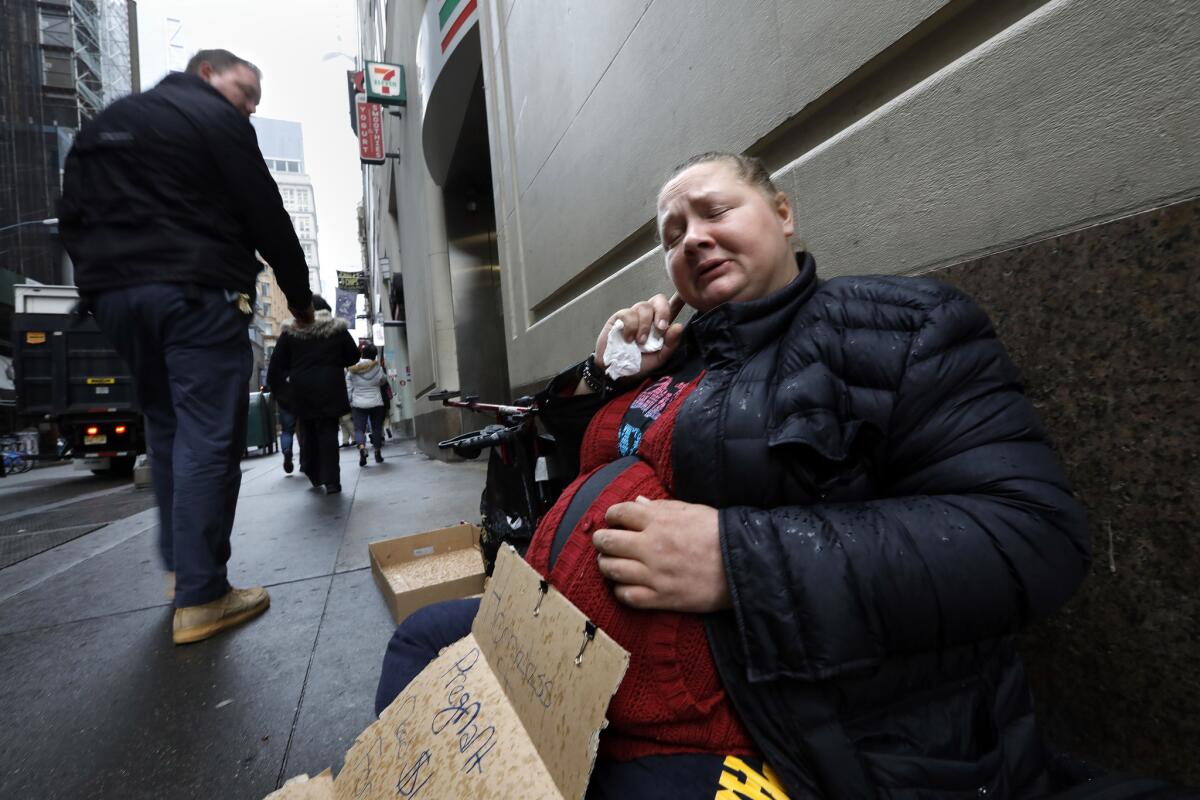
This fiscal year the Department of Homeless Services will spend nearly $1.6 billion, its entire budget, on providing shelter. Last fiscal year about 115,000 different men, women and children resided at some point in a city shelter, where the average stay is longer than a year.
Nearly a third of those provided shelter are housed in hotel rooms rented by the city or “cluster apartments,” units in typically low-income, residential buildings. On average, the city pays anywhere from $85 to $222 a day to provide shelter and services for a household.
A 2015 investigation by the city’s Department of Investigation found that the cluster apartments were “the worst maintained, the most poorly monitored, and provide the least adequate social services” of all shelters. The report described lax security, obstructed passageways, defective window guards and rooms crawling with vermin. In 2016, two napping sisters died when a radiator exploded in a cluster apartment.
The investigation also found deficiencies at hotel shelters, including rat and mouse infestations and broken fire and carbon monoxide alarms. Crime was also a problem.
Charmel Lucas, 50, and her husband have been staying at a Holiday Inn in Manhattan’s Chelsea neighborhood, at the government’s expense, for about a year. The couple share a sixth-floor double room with a full-size bed, TV, desk and dresser. A nonprofit brings in three meals a day, usually cold sandwiches. The high-rise hotel also accommodates tourists and other visitors to New York.
Lucas, who works with the advocacy group Picture the Homeless, has no complaints about conditions but said services could be better given the cost to house and provide social services for her and her husband — $7,716.10 a month, according to Lucas’ public assistance budget letter.
“You could at least house two households [with that money]. It’s taxpayer dollars that are being wasted,” Lucas said. “And I can’t even get a cup of hot tea.”
Under De Blasio’s “Turning the Tide” plan, the city will eliminate cluster apartments by the end of 2021 and hotel rooms by 2023. In their place will be a network of traditional shelters. The move will save the city $100 million and cut the number of homeless facilities nearly in half.
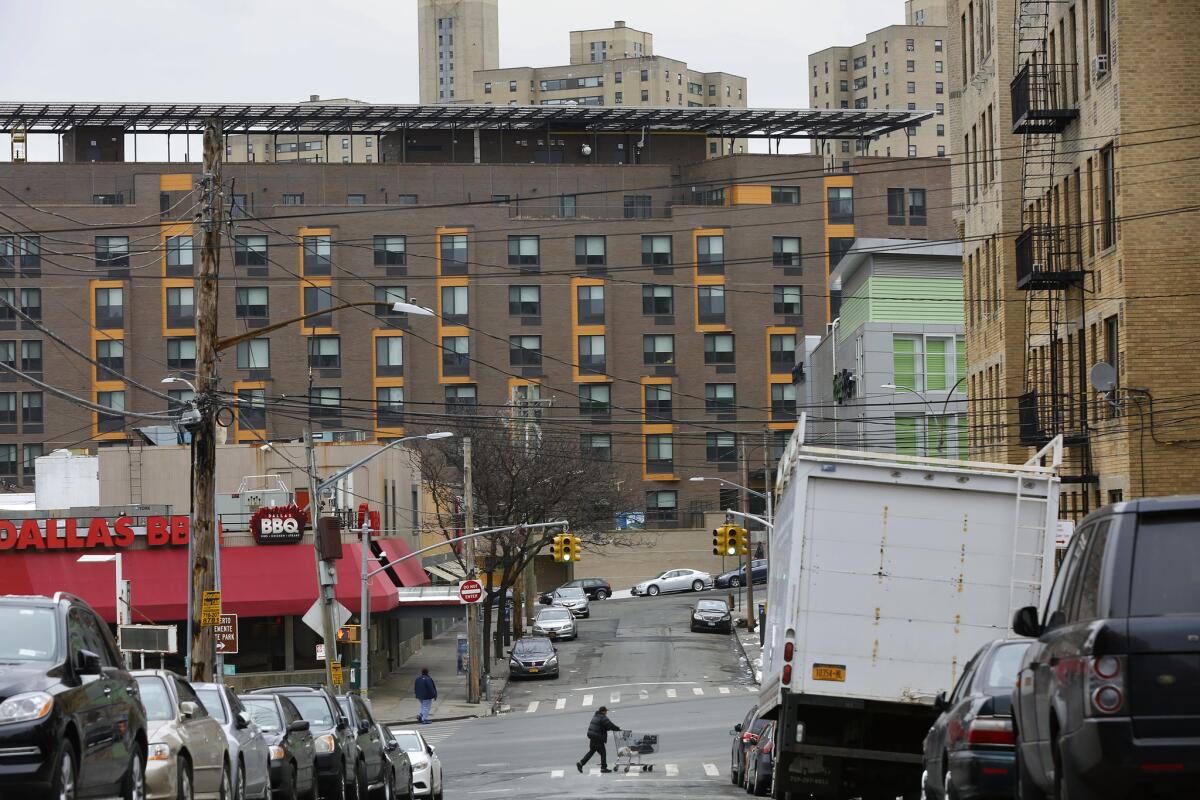
Designed specifically to house the homeless, the new shelters, accommodating anywhere from 80 to 400 people, may be located in converted hotels, armories or low-rise apartment buildings, or be built from the ground up.
As is currently the case, single adults will be typically housed in congregate settings, where cots line a room and cafeterias serve hot meals, while families will be placed in apartment-like units with kitchens and bathrooms. The plan also includes funding for maintenance and security overseen by the N.Y.P.D.
Additionally, the new shelters will offer space for social workers, who can help connect clients to social services, such as mental health care and employment training.
So far 11 new shelters have opened, with six more expected by June.
Jemal Johnson, 50, has been staying at a new 200-bed single men’s shelter in the Bronx since January. He was initially hesitant after hearing rumors of people being robbed or beat up while in the system. And his experience at a shelter run out of the old Bellevue psychiatric hospital in midtown was less than stunning.
“That place? That’s what makes some people scared,” Johnson recalled.
He was quickly transferred, though, to the Landing Road residences, a mixed-use facility run by the Bowery Residents’ Committee that combines a downstairs shelter with permanent housing upstairs.
At the shelter, Johnson shares a well-lighted room with 21 other men, where he keeps the covers on his twin bed neatly folded and his belongings organized in a padlocked wardrobe.
Every other week, Johnson meets with an “independent living specialist” who helps him figure out ways to save 60% of the income he earns working nights in customer service at Kennedy International Airport. And he gets help looking for housing.
“This place is...a lifeline,” Johnson said. Without it, he said, “I would’ve ended up on the street somewhere and I probably wouldn’t have been able to sustain my employment.”
A hallmark of “Turning the Tide” is to open shelters in the same boroughs where people first become homeless in order to give them the option of retaining ties to “anchors of daily life” — schools, jobs, churches, healthcare — that may make it easier to get back on their feet.
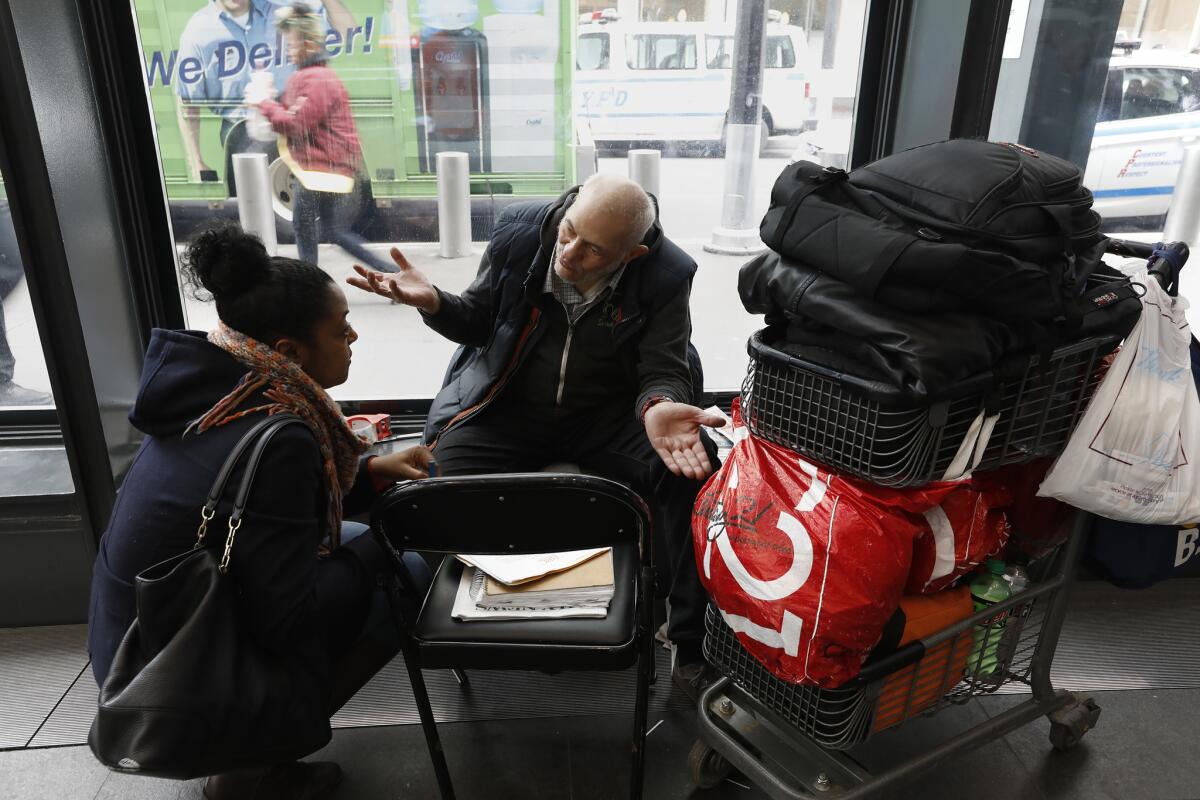
But already there has been an outcry. In Crown Heights, community groups last year protested the planned addition of new shelters in an area that is also home to a large assessment facility for single men. In Manhattan, residents are agitated over a planned shelter at the old Park Savoy Hotel, around the corner from a block known as “Billionaires’ Row.”
Steven Banks, the city’s homelessness czar, said the administration notifies communities about new shelters at least 30 days in advance and has modified some plans as a result. But, he said, the city is not backing off simply because some shelters are unpopular.
Even with the new approach, the city predicts only a modest decrease in homelessness: a drop of 2,500 people in shelters over the next five years.
“We think that plan is insufficiently ambitious,” said Shelly Nortz, deputy executive director for policy at the Coalition for the Homeless, a leading advocacy group that is pushing the mayor to set aside more housing for the homeless.
“The solution to homelessness for homeless households in New York City is to give them homes — the kind of homes [they can] live in in perpetuity,” Nortz said. “Until we do that, we’re not going to get a handle on the problem.”
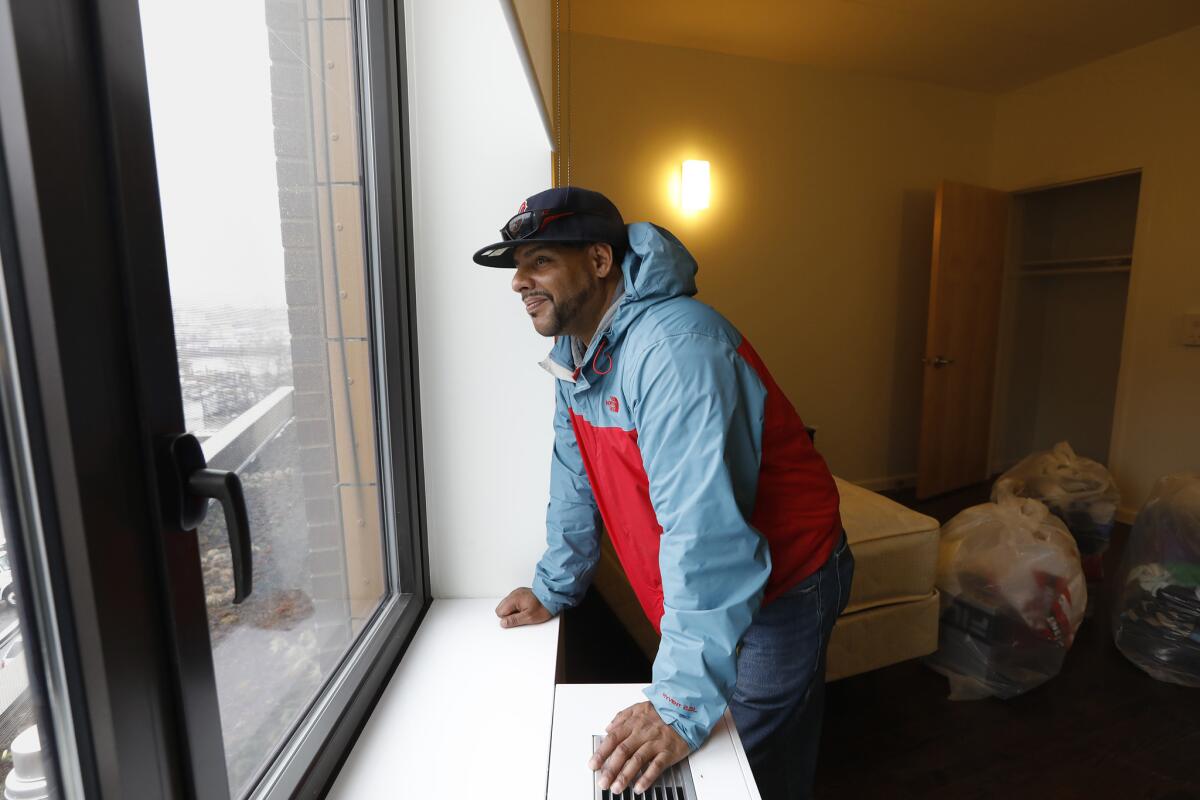
Jesus Melendez, 46, knows what that’s like firsthand.
The park maintenance worker from Yonkers was evicted after he suffered a heart attack and could no longer pay rent. Unable to find a new place he could afford, Melendez bounced around relatives’ apartments in Harlem and then ended up in shelter about a year ago.
With the help of case workers, he applied for the city’s rental subsidy and then for a low-income apartment at the Landing Road residences, just a few floors up from Johnson.
At the beginning of April, he moved in.
“I fell in love with it as soon as I saw it,” Melendez said of the studio with views of the Harlem River and an ample kitchen where he was eager to get back to cooking.
Best of all? The rent is just $470 a month — a well-below-market rate the Bowery Residents’ Committee can offer because it owns the building.
There are only 135 apartments in the building, though. Advocates say far more affordable units are needed, not only for people who are already homeless but also for those on the edge.
“It does make sense to have a shelter infrastructure — we’re going to need it,” Rachel Fee, executive director of the New York Housing Conference advocacy group, said. “But if you don’t have enough affordable housing options for people to go into, they just stay in shelter and more people come in, and it just keeps swelling.”
Still, Banks insists that De Blasio’s efforts are beginning to bear fruit. According to the city, its shelter census stayed flat between 2016 and 2017 rather than increased — a development the city considers a victory, however small.
“We know we have much more work to do,” Banks said, “but we can see signs of progress.”
Twitter: @AgrawalNina
More to Read
Sign up for Essential California
The most important California stories and recommendations in your inbox every morning.
You may occasionally receive promotional content from the Los Angeles Times.











